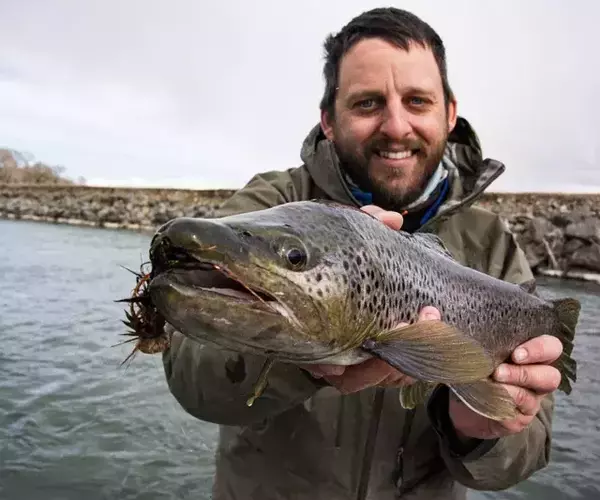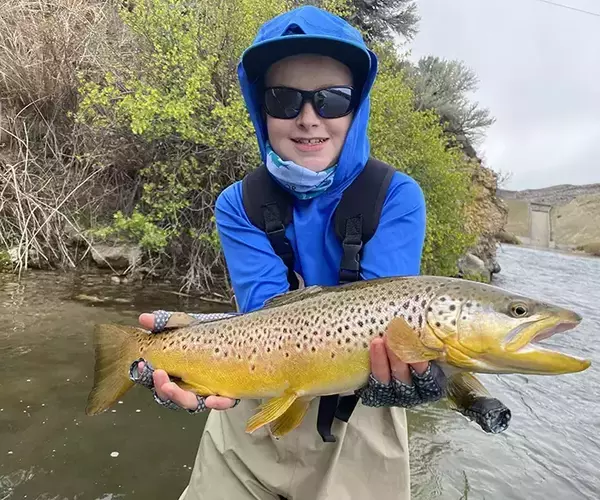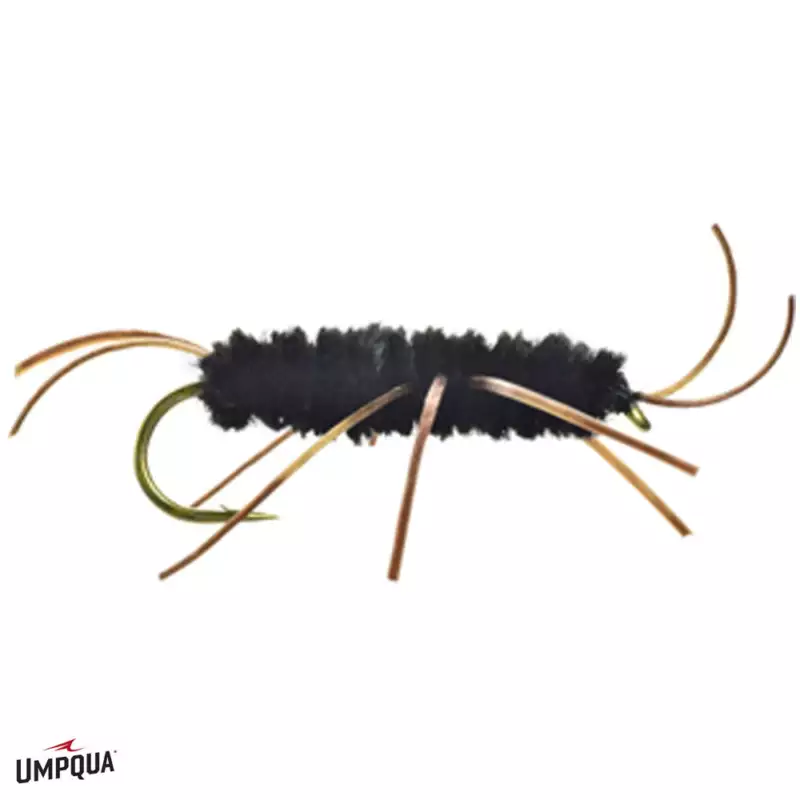7 Top Nymphs For Madison River Fly Fishing in Fall
Posted by: Alex
Date: 10/16/2025
If you are heading out for a day or two of Madison River fly fishing this fall, be sure that your fly box is well stocked with these time-tested classic nymph patterns.
7 Best Madison River Fly Fishing Nymph Patterns
The crowds of summer are gone, water temperatures are cool, and the fish are actively feeding throughout the day. Every year, fall delivers some of the best upper Madison River fly fishing for experienced anglers.
Brown trout become aggressive as their spawning season approaches, while rainbow and cutthroat trout actively feed during the season's final hatches of blue-winged olives. Although every angler dreams of those days filled with slow dry fly eats and explosive streamer action, the reality is that nymph fishing is the most consistent fly fishing technique for fall on the upper Madison.
As terrestrial insects become less and less available with the progression of the season, trout return their attention to aquatic insects as their primary food source. Although hatches may be sparse, the subsurface activity is abundant and diverse this time of year. Anglers fly fishing the upper Madison should be prepared with imitative nymph patterns of stoneflies, caddis, mayflies, and midges.
Many fly patterns will work just fine - especially when fished by a skilled angler - this time of year, but here are our guides' top nymph patterns for fly fishing the Madison River during the Autumn.

1) Pat’s Rubberleg
There’s not a nymph box in Montana that doesn’t have a few Pat’s rubberlegs in it. The fly imitates a stonefly nymph perfectly and is a staple of fly fishing in Bozeman. In the fall, brown, black, and tan are the go-to colors, with sizes 6 through 10 being the standard. Stonefly nymphs, especially golden stones, are particularly active during the colder months of the year.

2) Zebra Midge
When the water cools and hatches become sparse, midges take over. The zebra midge is one of those flies that just works, no matter what the conditions are doing. It’s simple, durable, and consistently fools fish. Black, red, and olive are all essential, with sizes 18 to 20 being most effective for most circumstances. It’s the perfect dropper behind a heavier fly and one you’ll want plenty of.

3) Micro Mayfly
The micro mayfly is a Bozeman fly fishing guide's favorite on just about any of the legendary wild trout rivers in the area. It’s slim, sinks fast, and is realistic enough to match the small mayfly nymphs that trout eat through October and November. Olive and brown are the top colors, and sizes 16 to 20 are right for the Upper Madison River this time of year. This Mike Mercer classic has a touch of flash that catches light in clear water without being too much.

4) Lightning Bug
Few flies balance flash and subtlety as well as the lightning bug. The gold and silver versions are our guides' favorites when floating the middle sections of the upper Madison River. On bright days, the lightning bug’s flash works great to attract feeding trout in riffles and fast runs. The gold bead adds just enough weight to keep the fly down deep, especially when it's fished as a dropper below a heavier stonefly or large attractor pattern.

5) Rainbow Warrior Perdigon
The rainbow warrior is one of those flies that shouldn’t work as well as it does. The combination of bright thread and its tinsel body gives it life in clear water and visibility in deeper runs. Sizes 14 to 18 are best, and it’s an excellent trailing fly behind a pat’s rubberleg or a small stonefly. In the skinny water sections between Varney Bridge and Ennis Lake, anglers will fish this about 2' below a small chunnby chernobyl to work trout feeding in really shallow runs.

6) Pheasant Tail Nymph
It’s hard to beat a classic, and the pheasant tail nymph remains one of the most effective patterns for Montana fly fishing on the Madison River. Its natural profile and lifelike movement imitate everything from mayflies to small stones, and trout never seem to get tired of it. Both standard and beadhead versions work, with sizes 14 through 18 being the sweet spot in natural or olive color ways. Flashback variations are particularly effective during BWO hatches.

7) Prince Nymph
The prince nymph is another timeless pattern that’s relied on by Bozeman fly fishing guides year-round. It’s durable, imitative, and consistently produces fish throughout the fall. Sizes 14 through 18 are best for the Upper Madison River, and fishing it in tandem with a blue-winged olive nymph can lead to some very productive sessions. Variations like the psycho prince, king prince, and "fly formerly known as prince" are all worth having, as well.
Fall Nymphing Tips for the Upper Madison
Fall nymphing on the Upper Madison is all about adjusting to changing conditions. Water levels stay steady, but temperature swings can make fish move in and out of different water types throughout the day.
- Focus on seams, softer edges, and deeper buckets during the mornings, then move into shallower riffles as things warm up.
- A two-fly setup covers most scenarios—a heavier attractor on top and a smaller dropper below.
- Adjust your weight often, and keep drifts short and controlled. Depth and presentation matter more than the pattern itself.
For anglers focused on Bozeman fly fishing, the upper Madison is hard to beat in the fall. The river stays consistent, the crowds are gone, and the fish are active from late morning through the afternoon. Nymphing this time of year is about rhythm and patience—watching your indicator, adjusting depth, and keeping in contact with your flies.
9 Foot Leaders Vs 7.5 Foot Leaders
When nymphing in the fall, the choice between a 9-foot and a 7.5-foot leader can make a big difference in how your flies drift. A 9-foot leader gives you more reach and a smoother presentation in clear water—something you’ll deal with often on rivers like the Madison or Gallatin this time of year. It helps keep distance between your indicator and the fly, which matters when trout are wary or the water is low.
A 7.5-foot leader, on the other hand, gives you more control in tighter water. It’s easier to manage in windy conditions and helps get your flies down faster when you’re fishing deeper runs or using heavier setups. The shorter leader turns over weight and indicators more cleanly, especially when you’re fishing close or wading pocket water.
In the end, both have their place—use the 9-footer when you need finesse and the 7.5 when you need control.
A 9 and a half foot 5 Weight For Nymphing in Montana
A 9.5-foot 5-weight rod offers better nymphing capabilities than a standard 9-foot rod, providing more reach and control. That extra length helps mend line, lift for longer drifts, and set the hook cleanly without pulling flies out of the zone.
Get Out There This Fall
Fall fly fishing in Montana is an experience every serious fly angler will relish. Whether you prefer wading or floating, this is an excellent time of year to explore the upper Madison River at a more leisurely pace. Anglers can fish streamers all day long or optimize their day around blue-winged olive hatches when conditions are just right.
However, nymph fishing is consistent and productive as we head into winter on all of the rivers near Bozeman, especially the upper Madison. Make sure that you have these top seven nymph patterns - and a few variations - in your Madison River fly box for the best results. These time-tested classics are constant companions in our guides' fly boxes and should be in yours, too.
Related Articles From The Montana Fly Fishing Blog

Category: Bozeman Fly Fishing Trip Planning, Tips on Flyfishing Montana Rivers
4 Best Fly Fishing Rivers in Montana
Post Date: 05/31/2024
Anglers traveling to Montana to fly fish for trout face a difficult question. Where to fish? You can’t experience all exceptional water here in a lifetime much less a single...
Read Article
Category: Tips on Flyfishing Montana Rivers
The Best Madison River Fishing Sections
Post Date: 03/14/2024
Floating the "50 Mile Riffle" is the best way to experience the world-renowned Madison River fishing that attracts anglers from around the world. Here are our Bozeman fly fishing guides'...
Read Article








